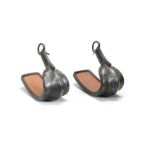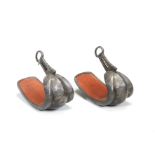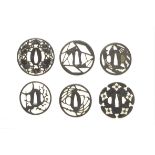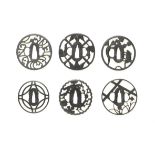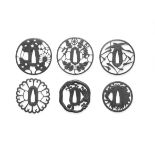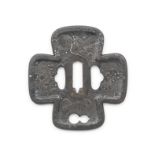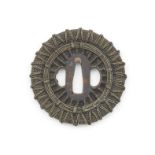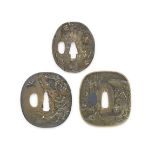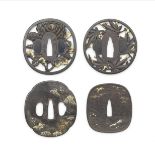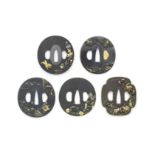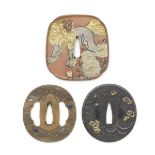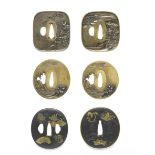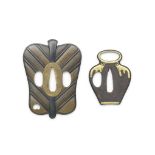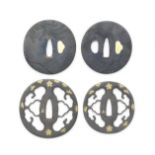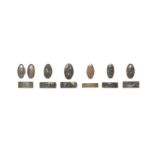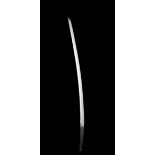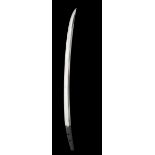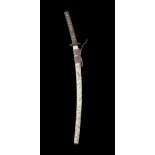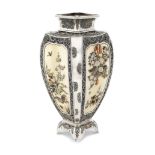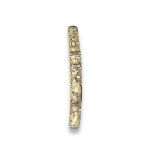Verfeinern Sie Ihre Suche
Schätzpreis
Kategorie
- Japanese Works of Art (294)
- Prints (21)
- Arms, Armour & Militaria (18)
- Ceramics (13)
- Chinese Works of Art (8)
- Oil, Acrylic paintings & Mixed Media (8)
- Books & Periodicals (6)
- Collectables (4)
- Ethnographica & Tribal Art (4)
- Coins (3)
- Furniture (3)
- Sculpture (3)
- Models, Toys, Dolls & Games (2)
- Musical Instruments & Memorabilia (2)
- Salvage & Architectural Antiques (2)
- Textiles (2)
- Entertainment Memorabilia (1)
- Jewellery (1)
- Metalware (1)
- Silver & Silver-plated items (1)
- Writing Instruments (1)
- Liste
- Galerie
Ein Abonnement der Preisliste ist notwendig um Ergebnisse, von Auktionen die vor einem längeren Zeitraum als 10 Tagen stattgefunden haben, ansehen zu können. Klicken Sie hier für mehr Informationen
A pair of inlaid iron abumi (stirrups) Inlaid by Yazaemon Nagatsugu of Kanazawa, Edo period (161...
A pair of inlaid iron abumi (stirrups)Inlaid by Yazaemon Nagatsugu of Kanazawa, Edo period (1615-1868), 18th centuryOf typical form, each inlaid o...
A pair of inlaid iron abumi (stirrups) By Nobukuni, Edo period (1615-1868), late 18th/early 19th ...
A pair of inlaid iron abumi (stirrups)By Nobukuni, Edo period (1615-1868), late 18th/early 19th centuryOf typical form, each inlaid on the front w...
Nine iron sukashi (openwork) tsuba (sword guards) Edo period (1615-1868), 17th to 19th century (18)
Nine iron sukashi (openwork) tsuba (sword guards)Edo period (1615-1868), 17th to 19th centuryUnsigned and circular except as noted, the designs as...
Nine iron sukashi (openwork) tsuba (sword guards) Momoyama (1573-1615) and Edo (1615-1868) period...
Nine iron sukashi (openwork) tsuba (sword guards)Momoyama (1573-1615) and Edo (1615-1868) period, late 16th to 19th centuryUnsigned and circular e...
Nine iron sukashi (openwork) tsuba (sword guards) Edo period (1615-1868), 17th to 19th century (18)
Nine iron sukashi (openwork) tsuba (sword guards)Edo period (1615-1868), 17th to 19th centuryUnsigned and circular except as noted, the designs as...
A kyo-shoami iron tsuba (sword guard)Edo period (1615-1868), 17th centuryFour-lobed cruciform with hammered-up rim, the well-patinated iron surfac...
A 'shingen' tsuba (sword guard)Edo period (1615-1868), late 17th/18th centuryCircular, the thick iron plate with elaborate bands of ropework in br...
Three sentoku (brass alloy) tsuba (sword guards)Edo period (1615-1868), 19th centuryThe first irregular oval, chased and inlaid in relief with Soj...
Eight iron tsuba (sword guards)Edo period (1615-1868), 18th/19th centuryThe first circular, pierce carved and modelled as a chrysanthemum plant (g...
Five shakudo tsuba (sword guards)Edo period (1615-1868), late 18th/19th centuryAll except the fifth almost circular, the first with nanako ground,...
Three tsuba (sword guards) Edo period (1615-1868) and Showa era (1926–1989), 19th/20th century (6)
Three tsuba (sword guards)Edo period (1615-1868) and Showa era (1926–1989), 19th/20th centuryThe first brightly patinated copper mokko with a hamm...
Four tsuba (sword guards)Edo period (1615-1868), 18th/19th centuryThe first iron, almost circular, chased in relief and inlaid in silver with a wi...
Six tsuba (sword guards)Edo period (1615-1868), late 18th/19th centuryUnsigned except as noted: The first two sentoku or brass, of similar design,...
A kenjo (presentation) tsuba (sword guard) By Bairyuken Kiyotatsu, Nishijin, Kyoto, Edo period (1...
A kenjo (presentation) tsuba (sword guard)By Bairyuken Kiyotatsu, Nishijin, Kyoto, Edo period (1615-1868), late 18th/early 19th centuryIron, of mo...
Two unusually shaped tsuba (sword guards)Edo period (1615-1868), late 18th/19th centuryBoth unsigned, the first copper alloy, in the form of a gun...
Two iron tsuba (sword guards)Edo period (1615-1868), 19th centuryThe first circular, chased in relief with the head of a grimacing ogre, perhaps t...
Two daisho (large and small) sets of tsuba (sword guards) Edo period (1615-1868), 19th century (6)
Two daisho (large and small) sets of tsuba (sword guards)Edo period (1615-1868), 19th centuryThe first set shakudo migaki-ji, each chased in katag...
Seven kozuka (knife handles)Edo period (1615-1868), late 18th/19th centuryThe first sentoku, inlaid in mixed metals with a monkey in a tortoiseshe...
Ten kozuka (knife handles)Edo period (1615-1868), late 18th/19th centuryThe first shibuichi, chased and inlaid with a goose and reeds by a stream,...
A set of kozuka (knife handle) and menuki (paired hilt ornaments), and eight kozuka (knife handle...
A set of kozuka (knife handle) and menuki (paired hilt ornaments), and eight kozuka (knife handles)The set: Style of Araki Tomei (1817-1870), Edo ...
12 kozuka (knife handles)Edo period (1615-1868), late 17th-19th centuryUnsigned except as noted, the first shakudo nanako, inlaid in gold and silv...
11 fuchi (hilt collars)Edo period (1615-1868), late 18th/19th centuryAll shakudo nanako decorated in mixed-metal relief as follows: the first a ti...
12 fuchi-gashira (matching hilt collars and pommels) Edo period (1615-1868), late 18th/19th centu...
12 fuchi-gashira (matching hilt collars and pommels)Edo period (1615-1868), late 18th/19th centuryThe first shibuichi, with horses chased in katag...
Five fuchi-gashira (matching hilt collars and pommels) Edo period (1615-1868), late 18th/19th cen...
Five fuchi-gashira (matching hilt collars and pommels)Edo period (1615-1868), late 18th/19th centuryAll shibuichi except the fifth, inlaid in mix...
A set of fuchi (hilt collar), kashira (hilt pommel), and kojiri (scabbard tip), and five fuchi-ga...
A set of fuchi (hilt collar), kashira (hilt pommel), and kojiri (scabbard tip), and five fuchi-gashira (matching hilt collars and pommels)Edo peri...
A set of kogai (skewer), fuchi-gashira (matching hilt collar and pommel), and menuki (paired hilt...
A set of kogai (skewer), fuchi-gashira (matching hilt collar and pommel), and menuki (paired hilt ornaments), and a mitokoromono (kozuka, kogai, a...
Nine pairs of menuki (paired hilt ornaments) Edo period (1615-1868), late 18th/19th century (27)
Nine pairs of menuki (paired hilt ornaments)Edo period (1615-1868), late 18th/19th centuryAll of mixed metal with relief inlay and chasing and uns...
A koto katana (long sword)By Kuniyasu, Nanbokucho period (1336-1392), 14th centuryOf elegant shinogi-zukuri form with ko-gissaki and shallow koshi...
A koto katana (long sword) Attributed to Kokubunji Sukekuni of Bingo, Kamakura period (1185-1333)...
A koto katana (long sword)Attributed to Kokubunji Sukekuni of Bingo, Kamakura period (1185-1333), early 14th centuryThe slender blade of shinogi-z...
A koto wakizashi (short sword) By Tajima Kunimitsu, Muromachi period (1333-1573), 15th century
A koto wakizashi (short sword)By Tajima Kunimitsu, Muromachi period (1333-1573), 15th centuryOf hira-zuri form with medium sori and bo-hi ni tsure...
A Shinto wakizashi (short sword)Edo period (1615-1868), early 19th centuryThe blade of shinogi-zukuri form, gunome-ha of nioi and nie, indistinct ...
A finely mounted aikuchi The blade: after Umetada Myoju, Edo period (1615-1868) or Meiji era (186...
A finely mounted aikuchiThe blade: after Umetada Myoju, Edo period (1615-1868) or Meiji era (1868-1912), late 19th centuryThe tanto blade of hira-...
A koshira-e (set of mounts) for a katana (long sword) The fittings: Edo period (1615-1868), 17th ...
A koshira-e (set of mounts) for a katana (long sword)The fittings: Edo period (1615-1868), 17th to 18th centuryThe saya of polished same, the iron...
A finely mounted daisho (set of long and short sword) The katana: by Yamashiro no kami Fujiwara T...
A finely mounted daisho (set of long and short sword)The katana: by Yamashiro no kami Fujiwara Toshinaga, Edo period (1615-1868), mid-17th century...
Two ivory figure okimonoMeiji era (1868-1912), late 19th/early 20th centuryThe first of Gama Sennin, clutching a gnarled cane attached with a gour...
Three ivory okimono figuresMeiji era (1868-1912), late 19th/early 20th centuryComprising: a mother standing and dressed in an elegant kimono, clut...
Two ivory okimono figures One by Yuho, Meiji era (1868-1912), late 19th/early 20th century (2)
Two ivory okimono figuresOne by Yuho, Meiji era (1868-1912), late 19th/early 20th centuryComprising an Ainu hunter, standing and holding a pole on...
An ivory okimono group of figuresMeiji era (1868-1912), late 19th/early 20th centuryComprising two kago (palanquin) bearers, one standing at eithe...
Four small ivory okimonoMeiji era (1868-1912), late 19th to early 20th centuryComprising: a seated oni (demon) seated with a tokkuri (sake flask) ...
An ivory okimono of a hunterMeiji era (1868-1912), late 19th/early 20th centuryStanding with a quiver strapped on his back and a dead bird suspend...
Two ivory okimono groupsMeiji era (1868-1912), late 19th to early 20th centuryComprising one of Daikoku, seated holding a sack and mallet atop a r...
Three ivory okimono figuresMeiji era (1868-1912), late 19th to early 20th centuryComprising: an eagle gripping with its talons a monkey lying acro...
An ivory okimono group of three monkeys By Hozan, Meiji era (1868-1912), late 19th/early 20th cen...
An ivory okimono group of three monkeysBy Hozan, Meiji era (1868-1912), late 19th/early 20th centuryComprising three monkeys huddled on the ground...
Five small ivory okimonoMeiji era (1868-1912), late 19th to early 20th centuryComprising: a group of five rats forming a circle, two offspring cla...
A small ivory okimono of a banana Meiji (1868-1912) or Taisho (1912-1926) era, late 19th/early 20...
A small ivory okimono of a bananaMeiji (1868-1912) or Taisho (1912-1926) era, late 19th/early 20th centuryNaturalistically carved with its skin pa...
An ivory and gold-lacquered small cabinet Meiji era (1868-1912), late 19th/early 20th century
An ivory and gold-lacquered small cabinetMeiji era (1868-1912), late 19th/early 20th centuryOf conventional form, with a symmetrical arrangement o...
A pair of ivory baluster vases By Kaneyuki, Meiji era (1868-1912), late 19th/early 20th century (2)
A pair of ivory baluster vasesBy Kaneyuki, Meiji era (1868-1912), late 19th/early 20th centuryBoth intricately and boldly carved in varying degree...
An ivory okimono group of the three sake testers By Ichiyusai Munetoshi/Soju, Meiji era (1868-191...
An ivory okimono group of the three sake testersBy Ichiyusai Munetoshi/Soju, Meiji era (1868-1912), late 19th/early 20th centuryConsisting of Shak...
An ivory four-panel folding screen By Otani Mitsutoshi, Meiji era (1868-1912), late 19th/early 20...
An ivory four-panel folding screenBy Otani Mitsutoshi, Meiji era (1868-1912), late 19th/early 20th centuryFinely carved in low relief with a conti...
An inlaid ivory and silver-mounted rectangular box and cover Meiji era (1868-1912), late 19th/ear...
An inlaid ivory and silver-mounted rectangular box and coverMeiji era (1868-1912), late 19th/early 20th centuryIntricately carved predominantly in...
A gold-lacquer and ivory okimono of the takarabune (treasure ship) By Eishin, Meiji era (1868-191...
A gold-lacquer and ivory okimono of the takarabune (treasure ship)By Eishin, Meiji era (1868-1912), late 19th/early 20th centuryThe ship lacquered...
A gold-lacquer, ivory and shibayama-inlaid portable rectangular kodansu (cabinet) Meiji era (1868...
A gold-lacquer, ivory and shibayama-inlaid portable rectangular kodansu (cabinet)Meiji era (1868-1912), late 19th/early 20th centuryApplied with 1...
A pair of silver-mounted, enamelled, and carved ivory vases By Hayashi Chikayuki/Shuko and Tomoma...
A pair of silver-mounted, enamelled, and carved ivory vasesBy Hayashi Chikayuki/Shuko and Tomomasa, Meiji era (1868-1912), late 19th/early 20th ce...
An inlaid ivory and lacquered oval box and cover Meiji era (1868-1912), late 19th/early 20th cent...
An inlaid ivory and lacquered oval box and coverMeiji era (1868-1912), late 19th/early 20th centuryFixed on an elaborate wood four-legged mytholog...
Two ivory and Shibayama-inlaid card cases and two game counters Meiji era (1868-1912), late 19th ...
Two ivory and Shibayama-inlaid card cases and two game countersMeiji era (1868-1912), late 19th to early 20th centuryEach card case lavishly decor...
A silver-mounted, ivory, silver filigree and inlaid Shibayama four-sided vase Meiji era (1868-191...
A silver-mounted, ivory, silver filigree and inlaid Shibayama four-sided vaseMeiji era (1868-1912), late 19th/early 20th centuryThe rectangular bo...
A Shibayama-inlaid and lacquered wood cabinet Meiji era (1868-1912), late 19th/early 20th century
A Shibayama-inlaid and lacquered wood cabinetMeiji era (1868-1912), late 19th/early 20th centuryConstructed in two separate sections and of conven...
A gold-lacquer Shibayama-inlaid and cloisonné-enamel rounded-rectangular tray By Nakayama Teimin ...
A gold-lacquer Shibayama-inlaid and cloisonné-enamel rounded-rectangular trayBy Nakayama Teimin (Gosokusai, born 1848), Meiji era (1868-1912), lat...
A gold-lacquer, silver-mounted, Shibayama-style vase By Miyamoto, Meiji era (1868-1912), late 19...
A gold-lacquer, silver-mounted, Shibayama-style vaseBy Miyamoto, Meiji era (1868-1912), late 19th/early 20th centuryThe spherical kinji body embel...
A gold-lacquer and Shibayama-inlaid tanto koshira-e (ornamental mounting for a short sword) Meiji...
A gold-lacquer and Shibayama-inlaid tanto koshira-e (ornamental mounting for a short sword)Meiji era (1868-1912), late 19th/early 20th centuryThe ...

